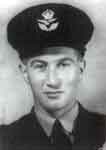RAAF MIA Beaufighter Discovery
by Phil Bradley

Photograph from "The
Searchers" of the recovery team looking at one of the Beaufighter
engines.
Two Beaufighters from 30th Squadron RAAF departed from Kiriwina Island on 25th November 1943 to carry out a sweep for barge traffic around the coast of New Britain from Rangandol Point to Cape Hoskins. After passing Bangula Bay, heading for home at 800 feet, Beaufighter A19-139 was seen to roll over on its back and dive into the jungle at a 45 degree angle. The two crew, pilot officer Charles Hilton Chapple and flying officer Percy John Coates were posted as missing.
Nigh on 52 years later in October 1995, Brian Bennett, a field manager for a forestry company on New Britain, following a lead from a local villager, came across the wreckage twelve miles south west of Kimbe. With him were Rod Marsland and Tony Aldridge, who had managed to land a helicopter in a nearby creekbed. The wreck was broken apart across a ridgeline amongst thick jungle and Bennett knew when he saw it that it had been undiscovered since the war.
Brian Bennett had spent many years looking for such aircraft wrecks and proceeded to systematically explore the wreck. In a nearby gully the two Bristol Hercules engines were found and on exploring fuselage sections the serial number was identified as A19-139. A message was sent out to the Australian High Commission in Port Moresby and soon thereafter the RAAF took over the recovery. Due to Brian Bennett's work the RAAF could be sure of the wreck identity before a crash team were sent in. When the team went in, the dog tags of both men were found and their identity further confirmed by a forensic dentist who accompanied the RAAF team.
Wing Commander Bruce Hudson had perhaps the most solemn task as he contacted Jack Chapple, still living on the family property at Greenthorpe in the Central west of New South Wales. "We've found your brother's plane" Hudson told him. A speechless Jack Chapple struggled to comprehend what that meant. He still remembered the postman coming to the property with the telegram, and how his mother, heartbroken by the loss, had gathered her missing son's letters and medals. Later she would look longingly at a photo of Rabaul's Bita Paka war cemetery where her son's name was inscribed as missing in action. Jack had kept it to himself, but he had idolised the older brother who had gone out to fight for his country, and now he was no longer missing.
On 22nd November 1995, exactly 52 years since they went missing, Charles Chapple and Percy Coates were laid to rest in Bita Paka war cemetery. Jack Chapple was there as was the sister of Percy Coates. May the two brave Australian pilots rest in peace. The story of Chapple and Coate's plane is one of many fascinating stories of wreck recovery to come out of the Pacific War.
Return to Phil Bradley Main Page


